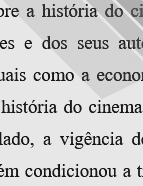

................................
In short, Manuel de Azevedo and Roberto Nobre were two of the main figures in film criticism who constantly disputed the official version of the history of Portuguese cinema produced by Félix Ribeiro and sponsored by public entities.
Also within the scope of criticism, but from an opposite ideological field to the last two examples, two names are particularly noteworthy: Manuel Moutinho Múrias published a significant work, História Breve de Cinema [Concise History of Cinema] (Editorial Verbo, 1962), devoting some poorly developed references to Portuguese cinema; and Fernando Duarte, a film club leader from Rio Maior, director of the film journals Visor [Screen] (1953-56) and Celulóide [Celluloid] (1957-1984) and author of publications such as Primitivos do Cinema Português [The Primitives of Portuguese Cinema] (Cinecultura, 1960), Elementos para a História do Cinema Português, do livro e a imprensa cinematográfica e do cineclubismo [Elements for the History of Portuguese Cinema, of the book, film press and film club] (Celulóide, 1976) and Apontamentos para a História do Cinema Português que não se fez [Notes for the Unaccomplished History of Portuguese Cinema] (Celulóide, 1978).
This inventory of the first historiographical writings on Portuguese cinema would not be complete without a reference to Alice Gamito, an author with invaluable work in the research on agricultural cinema. Like Félix Ribeiro, she undertook a two-sided task: a practical work in the organisation of the Filmoteca do Serviço de Informação Agrícola [Film Library of the Agricultural Information Service] and an editorial production on rural and agricultural cinema in Portugal, especially based on the activities promoted by the Festival de Cinema de Santarém [Santarém Film Festival].
This first phase of the historiography of Portuguese cinema, which can be marked between the first text by Félix Ribeiro (1946) and the first work entirely dedicated to the history of national cinema (A Aventura do Cinema Português [The Adventure of Portuguese Cinema] by Luís de Pina, 1977), was characterised by an important group of figures who were of particular relevance in the inventory and collection of dispersed materials, the validity and main value of which would become evident later on.
